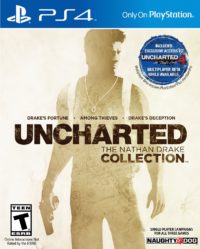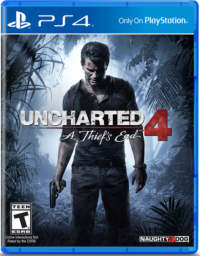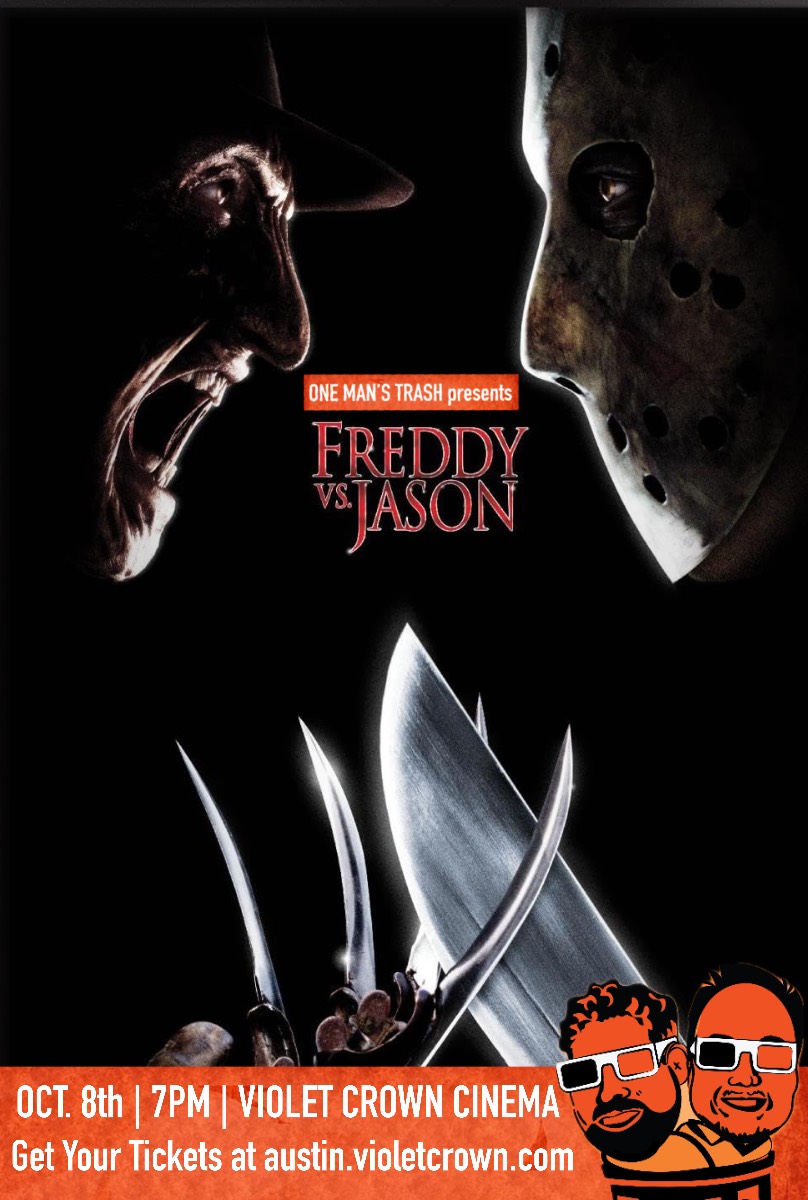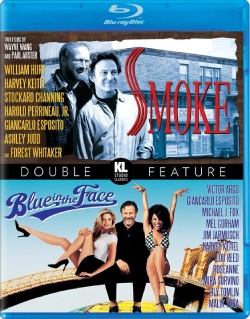“Sic Parvis Magna” roughly translates to: “Greatness from small beginnings.” In many ways, Sir Francis Drake’s iconic motto describes video game developer Naughty Dog as much as it does the titular hero of the Uncharted series, Nathan Drake. Long before they were acquired by Sony Entertainment in 2001, Naughty Dog had already been making a name for themselves in the mid-1990s with Crash Bandicoot. Capitalizing on their success with the platforming series, they eventually developed Jak and Daxter for the PlayStation 2. However, it was 2007’s PS3 exclusive title Uncharted: Drake’s Fortune, and its two sequels, Among Thieves and Drake’s Deception, that have affirmed Naughty Dog’s place as one of the premiere developers working in the video game industry today.
Though as successful as Nathan Drake’s adventures have been for Naughty Dog and Sony, eventually, all stories need to come to an end. It’s a difficult and incredibly daunting task to create a satisfying conclusion to any story, especially for a series of games that have prided themselves for their narrative storytelling and characters. Despite the enormity of facing such a problem, Naughty Dog has been able to succeed where many ongoing series, whether they been in film, television, or novels, have failed. Uncharted 4: A Thief’s End is a wonderful culmination of what Naughty Dog has learned over its many years as a developer, and it serves as a thrilling and definitive end to Nathan Drake’s story.
A Thief’s End takes place several years after the events of Drake’s Deception. Nate (Nolan North) has since retired from treasure hunting, married journalist Elena Fisher (Emily Rose), and has settled into a peaceful and relatively mundane life. Despite his commitment to Elena and his monotonous day job as a salvage diver, Nate still has lingering desires for adventure, and often reminisces about his days as a thief and treasure hunter. His desires for that life are reignited with the sudden re-appearance of his presumed-dead brother, Sam (Troy Baker). Though finally managing to escape from a Panamanian prison with the help of a notorious drug lord named Hector Alcazar (Robin Atkin Downes) after 15 years, Sam explains that his freedom has come with a hefty price. If he and Nathan don’t find the long lost treasure of the pirate Henry Avery, then Sam we’ll “wish” he was left in prison to rot. Hoping to erase Sam’s debt and find the treasure of Avery, Nate reunites with his mentor and father-figure, Victor “Sully” Sullivan (Richard McGonagle), and resumes the search that he and Sam started over 20 years ago, all the while competing with rival treasure hunters Rafe Adler (Warren Kole) and Nadine Ross (Laura Bailey).
When playing through the first few chapters of the game, it becomes apparent that A Thief’s End is a very different type of Uncharted in terms of storytelling and pacing. Elements of The Last of Us are all over Uncharted 4, from its initially slower pace to its quiet, grounded conversations between characters.
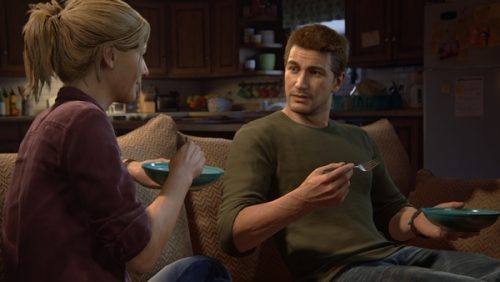
Nathan Drake, now older and wiser, is a more thoughtful and introspective person, and while he definitely hasn’t lost his sense of humor and wit, he’s far from the sarcastic adventurer we first saw in Drake’s Fortune nearly a decade ago. This is made all the more obvious when seeing Nate at home with Elena. The conversation that the two have over dinner reveals how their relationship has changed and evolved over the course of the series, and thanks to Nolan North and Emily Rose’s performances, the life that Nate and Elena share with each other feels wonderfully authentic.
Nate’s development as a character is further emphasized with the introduction of his brother, Sam. Troy Baker does a good job playing the character, but he’s mostly there to act as a catalyst for Nate. Though reunited after a decade, there’s an obvious rift between them, with Sam, now in his mid-40s, serving as an example of what Nate could have been had he continued with his obsessive and dangerous behavior.
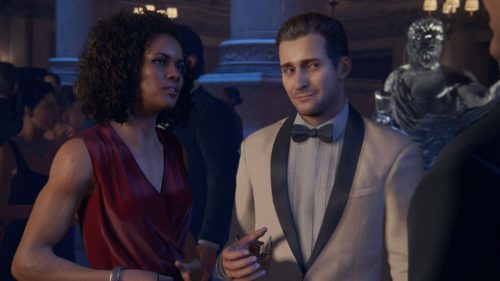
The game’s villains are also more compelling this time around, particularly Rafe, who despite being extremely wealthy, is not motivated by greed or accumulating power, but by the idea of cementing one’s legacy. His rivalry with Nate is easily the best of the antagonistic relationships in the series, and he, along with Nadine, bring a lot of personality to the game.
Even Avery himself, who is long dead, is a fascinating character, and the more you learn about him and the pirate utopia he tried to create in Madagascar further reaffirms Naughty Dog’s talent when it comes to character development and environmental storytelling.
The characters and environments are also given additional depth in terms of appearance and behavior thanks to the obvious graphical and animation advancements in A Thief’s End. All of the levels are suitably beautiful, and the way which Nate and the AI react to changes in the environment is leaps and bounds ahead of what Naughty Dog created in The Last of Us and previous entries in the Uncharted series. Nate now reacts and flinches when under gunfire, and will even make attempts to wipe water off his face. It’s a small thing that may go unnoticed by most players, but it only makes Nate feel more like a living-breathing person.
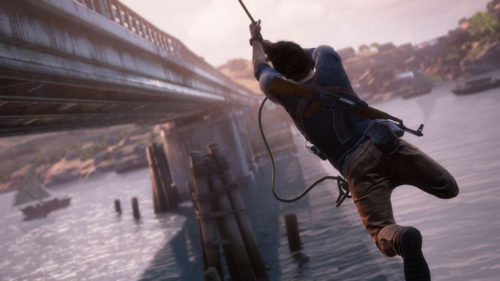
While the graphics and animation are all noticeably more advanced, what hasn’t changed too much in A Thief’s End from other Uncharted titles is the gameplay. Though there are numerous set-pieces throughout the game that will assuredly inspire awe when playing them, players will most often be tasked with traversing across large, but linear landscapes, solving puzzles and shooting many foreign sounding mercenaries in the face. The combat, while more fluid than any Uncharted game before it, is very familiar, and can sometimes feel repetitive in the last few chapters. The inclusion of a grappling hook, a new gameplay mechanic introduced to the series, breaks up the monotony of some climbing and platforming sections, and gives players a new and surprisingly fun way to explore various environments.
Other than the traversal platforming and the run-and-gun shooting, the other gameplay component that is featured heavily throughout the title is stealth combat. Though Naughty Dog has often struggled when implementing stealth mechanics in the Uncharted series, particularly in Drake’s Deception, they’ve finally managed to create fun and engaging stealth gameplay sections with A Thief’s End. Along with environments offering more options for players to hide and escape from an enemy’s line-of-sight, it’s now possible to mark and track enemies across an area. Though optional, the marking ability is a great aid to those wanting to avoid difficult enemy encounters on harder difficulties.
The single player campaign will roughly take 10-12 hours to complete, though it may take longer for more dedicated players who want to explore every single nook and cranny of the game’s environments, and collect every treasure, journal entry and hidden note. There are also “filter options” for players to choose from, which can change the visuals of the game and modify combat.

Outside of the campaign, multiplayer returns for the third time in the series, and it offers various ranked and unranked game types, including Team Deathmatch, Trials, Plunder and Command. As expected, the gameplay in multiplayer is similar to the base game, though there are a number of new modifications that elevate the multiplayer modes from previous entries in the series. Such modifications include “Mysticals,” which lets players harness some of the well-known supernatural elements and artifacts from the Uncharted games and books; and “Sidekicks,” which are AI allies that players can spawn to help assist in combat. Both the mystical artifacts and the ally spawns add a much-needed intensity to the multiplayer, and if used right, can effectively shift the balance of a match in one team’s favor.
Of the multiplayer modes that is the most exciting and dynamic, Command is by far the best, and tasks players with not only capturing “command areas” scattered around the map, but also to protect their respective team’s captain at the same time.
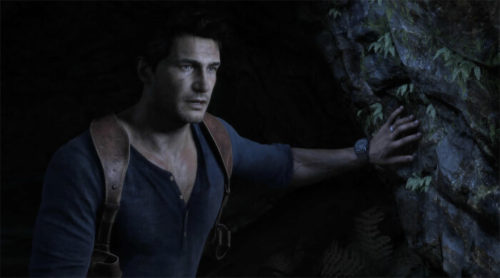
Looking back on Naughty Dog’s history with Uncharted, it’s easy to see how Uncharted 4: A Thief’s End came to be. The developer has always made a concerted effort to innovate and improve upon what they have managed to produce over the years. Yes, there are incredible action set-pieces and more realistic environments, but it’s the way which Naughty Dog has placed so much emphasis on storytelling and characters that A Thief’s End succeeds as much as it does. It’s that emphasis that makes the final shot of the game so emotional and fulfilling for players. In choosing to definitively end Nathan Drake’s story, Naughty Dog has left behind a legacy that will most assuredly inspire players and other developers for years to come.
Arbitrary Rating: 9.5 out of 10 strange relics.
Uncharted 4: A Thief’s End is currently available for purchase on PS4.
What about you reader? What did you think of Uncharted 4: A Thief’s End? Have you played the other games in the series? Let us know in the comments below!
Interested in picking up some of the titles mentioned in the article? Please use our Amazon links to do so!


